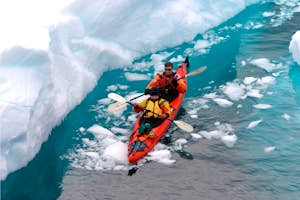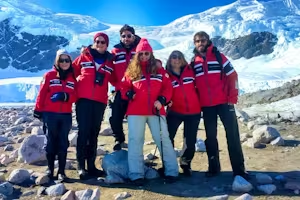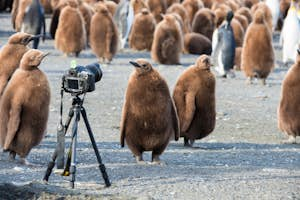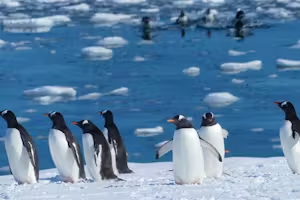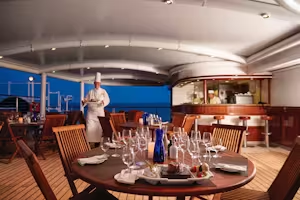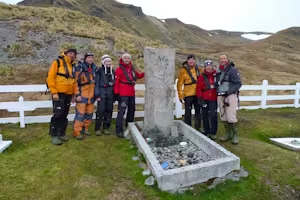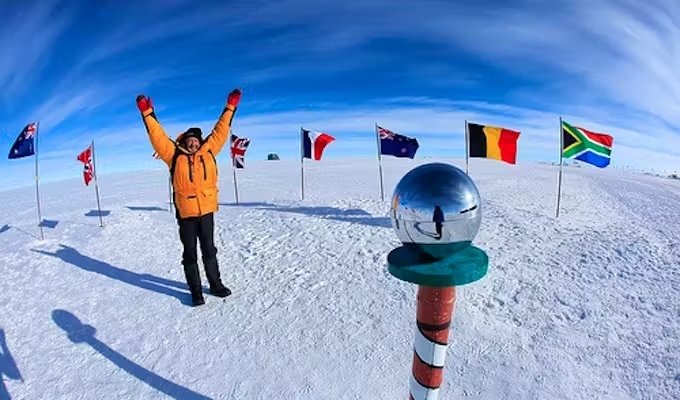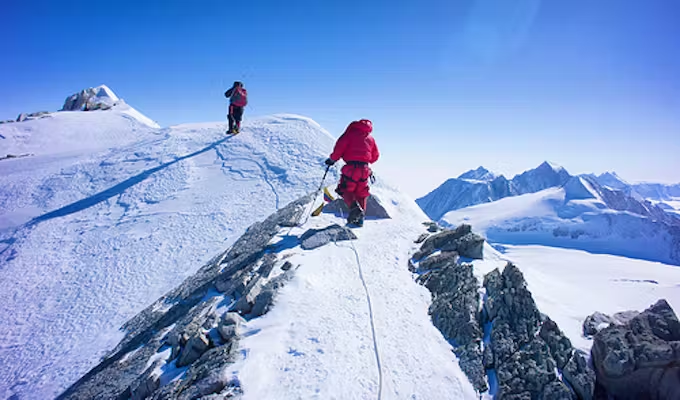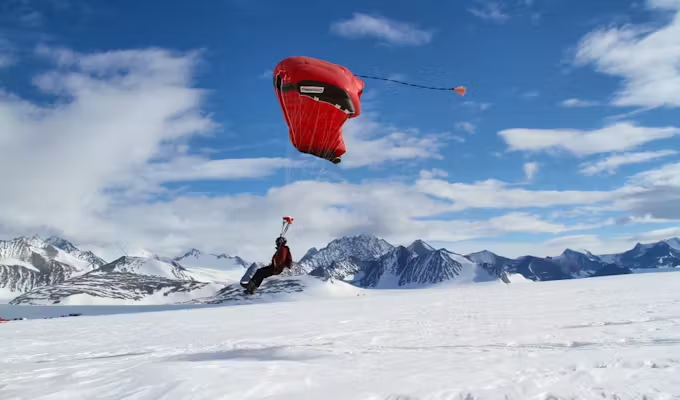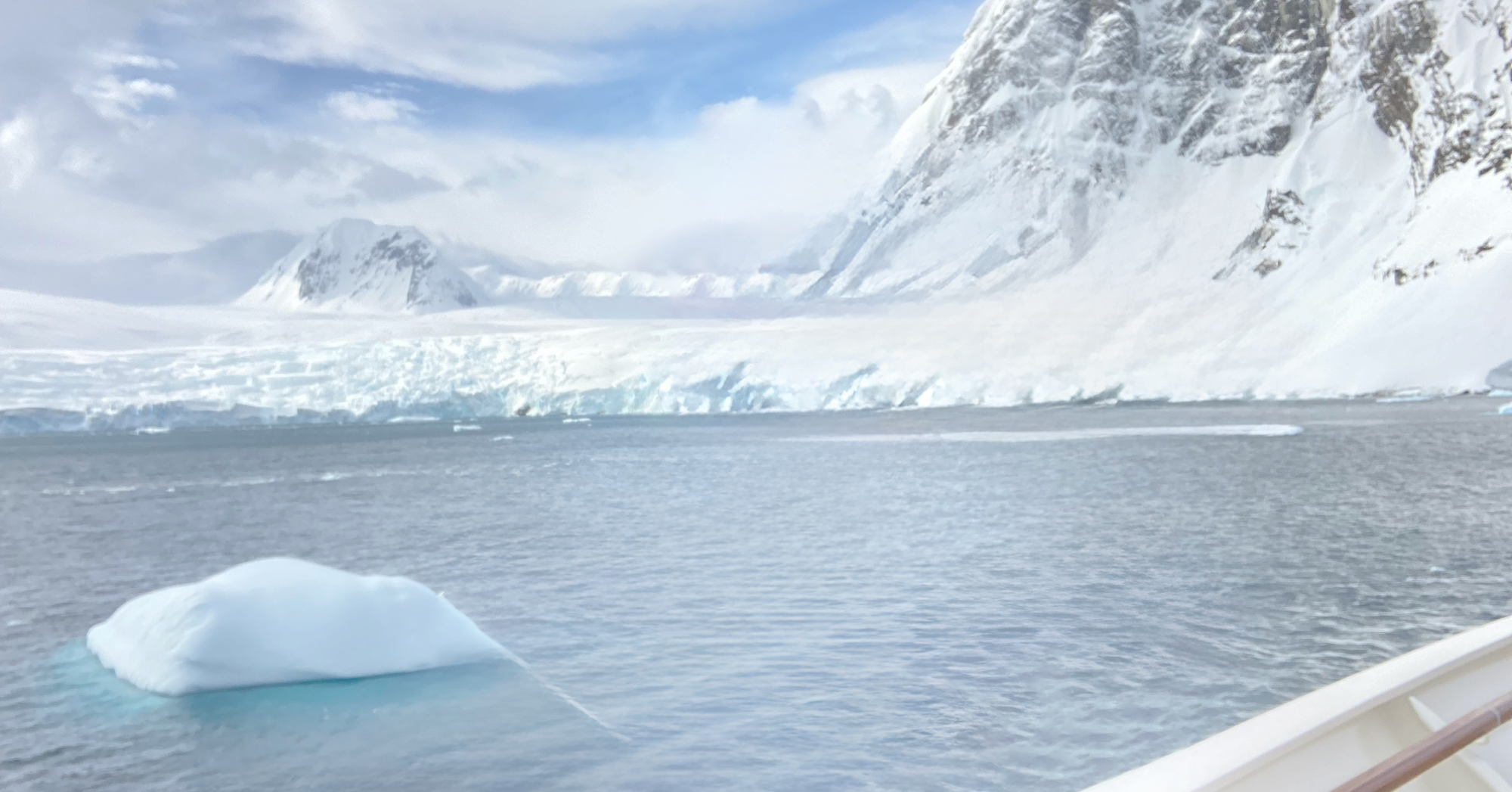What happens on a trip to the South Pole & Antarctic Interior?
Trips to the South Pole and Antarctic Interior are like no other experience, flying to remote camps by planes that land on blue ice runways to stay in isolated camps dwarfed by unbelievable landscapes. Visitors can expect adventure activities, extremes of ice and snow – and of course the chance to step foot on the southernmost point on the planet.
Antarctica's unpredictable polar weather means that flexibility is the centre of every adventure, but expert guides and logistical support ensure that the best of the heart of Antarctica is always waiting to be discovered.
Our most popular trips to the South Pole & the Antarctic Interior
Special Offers:Swoop has access to the widest range of offers and can help you find the right trip, cabin, & price.
What you'll experience at the South Pole & Antarctic Interior
Epic wilderness
While Antarctica’s coastline teems with wildlife, its interior is empty to the point of sterility. There is no wildlife at the South Pole or anywhere else: unless you’re making a dedicated trip to the emperor penguin colonies near the Weddell Sea, it’ll just be you and your travelling companions alone in the great white wilderness.
Instead, you’ll be inspired by wild glacier fields, craggy frozen mountains poking out from the permanent ice cap and the echoing silence left behind when the sound of your voices is stolen away by the wind.
Be prepared to feel as remote as the first explorers here: few places on Earth are as spectacularly isolated.

Isolation of the Antarctic Interior
Guide-led activities
World-leading outdoor guides will accompany you as you take part in a wide variety of activities in the Antarctic Interior and at the South Pole itself.
There is plenty of exploring to be done here in a variety of ways, from simple hikes to remote viewpoints to cross-country skiing. Beginners and experts alike can go ice climbing or exploring ice caves, or go on a skidoo or fat bike ride to the farthest horizon.
All activities are weather dependent, and operate according to the tightest safety protocols to ensure that your own personal explorations are carried out in the safest manner possible.
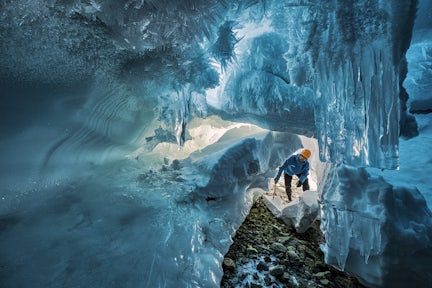
Exploring an ice cave
Polar transportation
The days of sledge dogs at the South Pole may be long gone due to environmental concerns, but there are plenty of modern ways to get around the Antarctic Interior.
The workhorse of polar operations here are ski-planes, which fly to the South Pole and other destinations, often stopping at the remotest fuel depots in the world. The pilots are some of the most experienced in the business, using advanced weather forecasting and operating within the strictest safety protocols.
Around the camps, transportation may be by skidoo or 4WDs specially modified for extreme polar conditions.
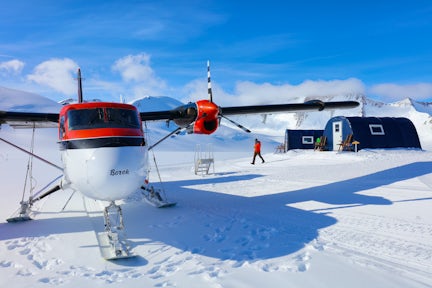
Twin Otter ski plane in the Antarctic Interior
Extreme climate
The Antarctic interior is quite simply the coldest place on the planet. While temperatures on the Antarctic Peninsula are relatively balmy, hovering around 30F (-1C), the South Pole rarely climbs above -13F (-25C). Temperatures across the Interior can drop to -40F (-40C) when windchill is taken into account. In addition, the high altitude of the polar plateau can also make a body feel colder. Appropriate clothing is absolutely essential.
Detailed packing lists for required clothes and equipment are provided to get you ready to travel, and some items – including parkas, boots and cold-rated sleeping bags – can be rented for the duration of a trip.
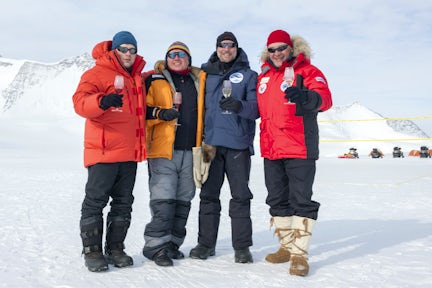
Dressed for the South Pole

Swoop says
All trips to Antarctica are ruled by the weather and stringent safety protocols. Before you fly, you'll receive a detailed safety and enviromental briefing, as well as the weather updates. The operators use their own detailed forecasters to ensure you'll get the best out of your trip.
Antarctic accommodation
There are no hotels at the South Pole or in the Antarctic interior. Accommodation is in a variety of tented camps, sleeping in well-insulated tents or pods, that can be solar heated thanks to the 24-hour sun.
Depending on the camp, most meals are taken communally with other guests in special dining tents, though some luxury camps offer private dining. There are separate bathroom tents: showers are available, but may be restricted for environmental reasons.
In remote areas, such as at the emperor penguin colony at Gould Bay or while mountaineering, simple field camps are often used. These offer a more stripped down experience, in true expedition style.
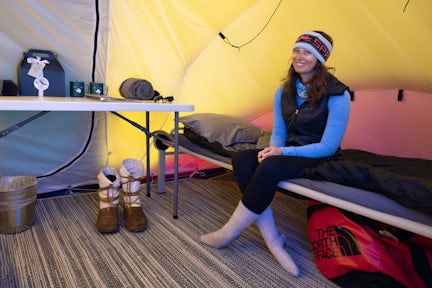
Insulated tent in the Antarctic Interior
Leave no trace
Trips to the South Pole and Antarctic Interior operate to the highest environmental protocols as laid down by the Antarctic Treaty and the International Association of Antarctic Tour Operators (IAATO). All camps are run on a strict leave no trace principle, so that they may be dismantled without leaving any permanent mark on the environment.
Anything brought into the camps must be removed at the end of a trip. This includes grey water from washing and human waste: bathrooms even separate solid and liquid waste to more easily dispose of it safely on leaving Antarctica. Likewise, rigorous operational procedures are in place to minimise the risks of pollution from any transportation.
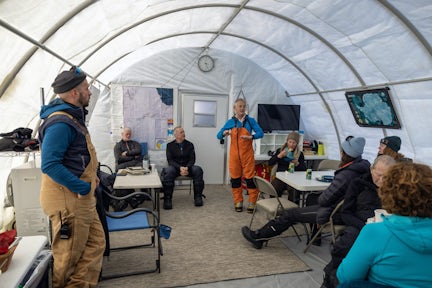
Briefing at South Pole Camp

Swoop says
To minimise water usage during your trip, it's recommended to bring a supply of wet wipes and hand sanitiser to use between showers. But it's also possible to take a 'snow shower' – perhaps the most extreme way of getting clean that you'll ever have experienced!
What to expect at the South Pole & Antarctic Interior: FAQs
-
How fit do I need to be to visit the South Pole or Antarctic Interior?
All travellers to the South Pole or Antarctic Interior need a moderate level of fitness and have good mobility. You may be asked to completed a medical form at the time of booking, as these trips operate in the remotest parts of the world.
It's important to note that the South Pole is at an altitude of 3300 m (11,000 feet), which can lead to shortness of breath and headaches. There are highly trained doctors in the Antarctic camps and a medic accompanies all trips to the South Pole.
-
How cold does it really get?
It gets very cold! Temperatures at the South Pole average around -13F (-25C) and can drop even lower, with wind chill making things even colder. This is considerably colder than the Antarctic Peninsula, so if you have done an expedition cruise there be aware that your gear from that trip may not be warm enough.
Detailed packing lists are provided to ensure that you arrive for your trip with appropriate clothing. Gear can also be rented in advance.
Tented accommodation in the Antarctic Interior is heated and well insulated.
-
What if I need to use the bathroom during an excursion?
All trips to the South Pole and Antarctic Interior operate on a strict 'leave no trace' principle, which includes human waste. While on excursions, you will be provided with a pee bottle in case you get caught short. Excursions that use vehicles may provide a portable toilet.
-
What time is it at the South Pole?
All lines of longitude and time zones converge at the South Pole, so in theory the time can be whatever you want it to be! For operational reasons, trips run on the same time zone as their point of origin, which will be either Punta Arenas in Chile or Cape Town in South Africa.
-
How long does it take to get to the South Pole?
It took Roald Amundsen eight weeks to reach the South Pole in 1911, but today's travellers can do the trip in a few hours by plane.
From Union Glacier, it takes around five hours to fly to the South Pole. From Whichaway Camp, it takes around seven hours to fly to the South Pole, including a dramatic refuelling stop on the polar plateau itself.
-
Can I visit the Amundsen-Scott Base at the South Pole?
Before Covid, it was sometimes possible to visit the US-run Amundsen-Scott Base at the South Pole, but this is not currently possible.
To evoke the spirit of the explorers it is named after however, visitors often land some distance from the pole, to walk the final stretch on foot, to achieve their own personal South Pole records.
Swoop. Your adventure story.
Market-leading expertise
Harness our 400,000 hours of Antarctic experience. There’s no question we can’t answer.
Impartial advice at no extra cost
Expert advice on over 1500 voyages to help you discover your perfect trip - and we don’t charge a fee.
B Corp certified
We care deeply about protecting Antarctica, that’s why 1% of our revenue goes to conservation.
A full concierge service
Access our exclusive pre-travel webinars — one of the many ways we make sure you’re Antarctica’s best-prepared travellers.
Ready to plan your Antarctic adventure?
Listen
We'll spend some time listening to your aspirations, then discuss the kind of experience that might suit you.
Match
Next we'll discuss the options, shortlist the best trips for you and present you our impartial recommendations.
Reserve
We'll place a 24 hour hold on your preferred option - without obligation - whilst we talk through the details.
With over 100 years of Antarctic experience between us, we can help guide you to exactly the right trip for you.
1-888-970-4570

